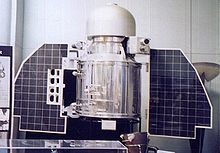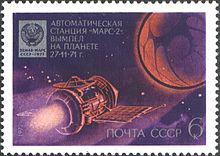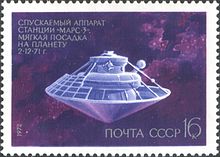Mars (space probe)
| Mars 1 to 7 | |
|---|---|
 Model of the Mars 1 probe |
|
| NSSDC ID |
|
| Mission objective | Exploring Mars |
| operator | Soviet Union |
| Launcher | Molnija ; proton |
| construction | |
| Takeoff mass | between 890 and around 4000 kg |
| Course of the mission | |
| Start date | 1960 to 1973 |
| launch pad | Baikonur |
The Mars spacecraft were a series of Soviet spacecraft launched for the planet Mars . In addition to the named space probes, there were a number of false starts, which either were not given a designation because the rocket exploded or were designated as satellites under Sputnik and Kosmos aliases in the event of reaching earth orbit . In addition, a space probe (Zond 2) flew to Mars as part of the Zond program. Another (Zond 3), which presumably missed its launch window, tested communication over interplanetary distances.
On October 10 and 14, 1960 the first attempts to launch two Mars probes on Molnija launch vehicles were made, which failed. They were developed together with the Venera 1 space probe and used the same bus . They weighed 480 kg and, in addition to experiments to investigate interplanetary space, also carried a camera system. These starts are often referred to in the literature as Mars 1960A and Mars 1960B .
Mars 1
Mars 1 (internal name of the satellite type 2MV-4) took off on November 1, 1962. Two more identical probes only reached earth orbit on October 24 and November 4, 1962 due to the failure of the fourth stage of the Molnija launcher. These starts are referred to as Sputnik 22 and Sputnik 24 . In addition to experiments to investigate cosmic rays and particles, Mars 1 also carried a camera system and a UV spectrograph. Both exposed a film that was developed on board and later digitized. An experiment to search for life by spectrometry was removed before launch. Mars 1 weighed 893.5 kg when launched with a Molnija rocket, had a total length of 3.3 m and (together with the unfolded solar cell booms) a width of 4.0 m.
After the start, the engineers found that the pressure in the fuel tanks for the nitrogen for position control had dropped to zero due to a valve that was not closed. As long as the probes were close to the sun, they could be stabilized by their gyroscopes . With increasing distance from the sun, the output of the solar cells decreased, so that there was no longer enough electricity to operate the gyroscope. Mars 1 lost its orientation in space and contact was lost on March 21, 1963 at a distance of 106 million kilometers from Earth. On June 19, 1963, the space probe passed Mars.
A modified variant of the Mars probe (type 3MV-4A) was cautiously launched on November 30, 1964 under the name Zond -2 . However, this mission failed because one of the two solar panels did not unfold.
Mars 2 and 3
In 1969 two more Mars probes were launched. Compared to Mars 1, the launch mass was significantly increased by the much more powerful Proton launcher . The probes now weighed over 3,800 kg. A lander was supposed to be carried, but was removed before take-off. Both probes, often referred to as Mars 1969A and Mars 1969B in the literature , were lost due to false starts on March 27 and April 2. In the first, the third stage did not ignite, in the second, the rocket exploded due to an engine failure at a height of only 50 m, whereupon the launch pad could no longer be used for months due to the contamination of the area by the toxic fuels.
Mars 2 and Mars 3 were identical probes from the Lavochkin design office near Moscow, which were developed under the direction of chief designer Georgi Babakin . Another probe, which was named Kosmos 419 , remained in earth orbit due to the failure of the upper stage (incorrect entry of the ignition point) on May 10, 1971. The task was to set down a lander weighing around 450 kg on Mars and send its measurement data to Earth. Then the two orbiters should examine Mars from orbit. With a launch mass of 4,650 kg, the probes were the heaviest in the Mars program. They were equipped with infrared radiometers for temperature measurement, an infrared photometer for determining carbon dioxide and water vapor absorption, microwave radiometers for measuring temperatures at a depth of 30 to 50 cm below the surface of Mars, a UV photometer for detecting various gases in the atmosphere, particle spectrometers and two cameras . In addition, the lander had a Rover type PROP-M on board, which should be removed automatically from the lander. The data connection would have been made by a 15 meter long cable.
After the launches on May 19, 1971 and May 29, 1971, both probes were the first Soviet probes to reach Mars without any problems. In both orbiters, however, the automatic control system that was supposed to calculate and correct the course failed. The orbiters both entered unscheduled orbits on November 27, 1971 and December 2, 1971. Misalignment of the landers also resulted in the loss of Mars 2. The lander entered the atmosphere too steeply. It may also be in the landing area near Hellespontus Montes (45 ° south, 47 ° east) , which later turned out to be very fissured, shattered.
After landing in the edge region of the Ptolemy crater (45 ° south, 158 ° west) , the lander of Mars 3 began to transmit a panorama, but fell silent after a few seconds (data transmission started 90 seconds after landing, transmission stopped 20 seconds later ). The scientists see the cause of the failure in a global dust storm that raged at the time. The orbiters took pictures on film. Before the dust storm subsided, the particles had exposed the film so that the images only show a few details.
Mars 4 to 7
Mars 4 to 7 should be the first to successfully land on Mars before the Viking probes. Since Mars was not so favorable to Earth in 1973 and the probes had to be lighter, the tasks were divided: Mars 4 and 5 brought two orbiters into space and Mars 6 and 7 two landers.
A few months before the start, checks showed that the contacts of the 2T-312 transistors had corroded and that the power supply to one of the probes had failed. An investigation showed that this error was systematic and was based on the fact that gold had been replaced by aluminum on the contacts in the manufacturer's works. A change in production would have taken six months and would have made it necessary to postpone the start to 1975. The political leadership decided to launch the probes anyway, even though there was only a 50 percent chance they would reach Mars. The take-off mass was 3,440 kg for the two orbiters and 3,250 kg for the landers.
The scientific payload of probes each consisted of two cameras, infrared radiometer , different photometers , gamma - spectrometer , magnetometer and particle detectors. In addition to cameras, the landers also had anemometers, thermometers and barometers on board.
Mars 4 started on July 21, 1973. On the way to Mars, the bus electronics failed. The instruments, which worked autonomously, could be activated on February 10, 1974 when they flew 2,200 km past Mars and transmitted some data. The bus, which was supposed to swing into orbit, was no longer addressable at this point.
Mars 5 took off on July 25, 1973. After two course corrections, it reached a 1,760 × 32,586 km high orbit on February 12, 1974 as planned. Although the measurement program was accelerated due to the problem identified above, the orbiter failed on February 28, 1974. The cause, however, was not determined to be the failure of the electronics, but rather the pressure loss in the bus caused by a micrometeorite hit. About 100 photos and other measurements were obtained.
Mars 6 took off on August 5, 1973. A few days after a course correction maneuver on August 13, 1973, a telecommunications channel of the transmitter failed due to a defective transistor. The lander was automatically disconnected from the silent probe on March 12, 1974. It provided measurements until touchdown at 25 ° west longitude and 24 ° south latitude, but then fell silent. Either it crashed on the surface or overturned on landing.
Mars 7 started on August 9, 1973 as the last of the quartet. On August 16, 1973 there was the only course correction maneuver. Here, too, transistors failed and there was only one communication channel left to the probe. The separation of the lander took place automatically on March 9, 1974, but four hours too early, so that the lander flew past Mars at a distance of 1,300 km.
Conclusion
The Soviet Mars program in the 1960s and 1970s was one of the biggest failures in the history of Soviet space travel . Of the 14 Mars program probes launched, only Mars 5 was a relative success. Later there were four other Soviet-Russian missions to Mars: Fobos 1 + 2 in 1988, Mars 96 in 1996 and Fobos-Grunt in 2011. Fobos 1 and Mars 96 were complete failures, only Fobos 2 was able to do a small part of its planned Carry out research program before it is lost too. With Fobos-Grunt, the last Russian mission to Mars up to that point also failed.
See also
swell
- Bernd Leitenberger: The "Mars" space probes.
- Sven Grahn: Soviet / Russian Mars Probe Launches. (English).
- VG Perminov: The Difficult Road to Mars. A Brief History of Mars Exploration in the Soviet Union. NASA History Division, Washington, DC, ISBN 0160588596 , PDF; 8 MB.
Individual evidence
- ↑ Harro Zimmer: Russia's Way to the Planets. In: Stars and Space . April 18, 2008, pp. 60-63.
- ↑ Christoph Seidler: Space probe crash. Waiting for the 127 million euro fireworks display. In: Spiegel.de. January 5, 2012, accessed January 5, 2012 .







